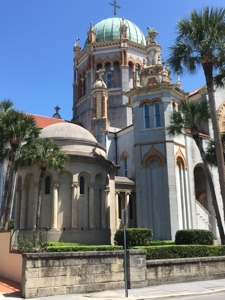 |
| Ponce de Leon Hotel |
Henry Flagler's name might not be as well-known as his Standard Oil Company partner, John D. Rockefeller, but Flagler certainly left his mark on St. Augustine, FL.
The son of a itinerant Presbyterian minister, Flagler, who left school when he was 14, rose from poverty to become one of the wealthiest men in America.
 |
| Clockwise from upper right, Mary Harkness (m. 1853-1881), Ida Alice Shrouds (m. 1883-1901), Mary Lily Kenan (m. 1901-1013) |
He first visited St. Augustine while honeymooning with his second wife, Ida Alice Shrouds. The city's charm so beguiled him that he and a local physician, Dr. Andrew Anderson, came up with the idea of turning it into a winter playground for the wealthy.
From Anderson, Flagler purchased a tract of land just beyond the historic city wall and proceeded to build two lavish hotels. To transport tourists to the city, he bought a short line railroad, the Florida East Coast Railroad which under his leadership, extended south to Palm Beach, then Miami and finally to the deep water port on Key West.
When the 540-room Ponce de Leon opened in 1888, it was a tremendous success. Instead of reserving a night or two, wealthy patrons willingly forked over $4,000 in cash to stay the entire winter season from December through April.
The lobby is stunning with its gold-leafed vaults and dome.
So is the richly ornate dining room, now the cafeteria of Flagler College, a private 4-year liberal arts school, which acquired the hotel in 1966. Tiffany windows and a theme of Spanish exploration make this, in the opinion of architect George E. Kidder-Smith, "one of the greatest rooms in America."
Tim and I signed up for a tour led by one of the college students. Her extensive knowledge of Flagler and the hotel was impressive.
 |
| Front facade of the Ponce de Leon Hotel |
One tidbit she pointed out are the Celtic crosses placed in a continuous row across the top of the hotel's roof-line and the cross on top of the domes, indicative of Flagler's strong faith. Flagler and his partner Rockefeller both seemed to believe that their prosperity was given by God, quite an interpretation of Jesus's command to leave all and follow Him.
The lounge where hotel guests gathered to visit and play card games features a large fireplace made of white onyx.
The Hotel Alcazar was built almost simultaneously with the Ponce de Leon; it too, opened in 1888. It featured a spa, a Turkish bath and a large indoor swimming pool.
Built around a central courtyard, the hotel served the overflow of tourists that its sister hotel turned away. Today Hotel Alcazar functions as City Hall while three of its floors house the Lightner Museum with its exhibits of Gilded Age artifacts.
When another St. Augustine businessman, William W. Smith, fell into financial difficulties, Flagler purchased his hotel, Casa Monica, and promptly renamed it the Cordova.
With this trio of luxury hotels, Flagler had a lock on the city's tourist trade. The Cordova once again called Casa Monica is now part of the Marriotts' string of hotels.
Yet, my favorite of all the structures Henry Flagler built in this city is the Memorial Presbyterian Church.
Built in the Venetian Renaissance Revival style, the church was dedicated to the memory of Flagler's daughter, Jenny Louise Flagler Benedict, who died from complications from childbirth.
 |
| Clockwise from upper left: Dome, Chapel, Sanctuary, Windows that describe The Apostles Creed in stained glass |
Using the plans Flagler requested from St. Mark's Bascilia in Venice, Italy, construction of the church was completed in a single year--1889.
Laid out in the shape of a Greek cross, three sides of the sanctuary are filled with parishioner pews.
The pulpit commands the fourth side. Tim and I stopped by the church Thursday afternoon for an informal visit with one of its docents; then, returned Sunday morning to worship at the early service.
Upon his death in 1913, Flagler was interred here along with his first wife, Mary Harkness Flagler, his daughter Jenny and his granddaughter Margery.
With these landmarks of St. Augustine, Flagler put his mark upon the city that continues to this day. His Presbyterian minister father would be pleased.
















No comments:
Post a Comment